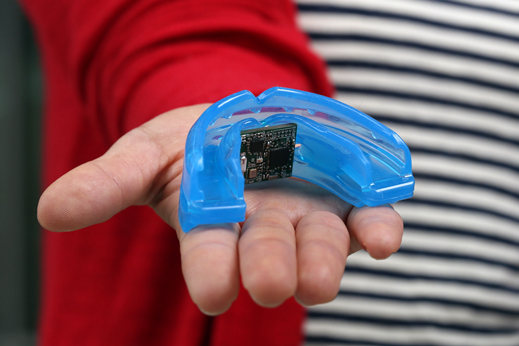Smart Mouthguard Monitors Your Saliva and Your Health
Your spit says a lot about your health, and now there’s wearable technology being tested to track it.

Researchers at the University of California, San Diego, have demonstrated a mouthguard with electronic sensors that can detect concentrations of certain chemicals in saliva. Such a gadget could be useful to soldiers, pilots, athletes, and even hospital patients.
The group recently revealed a new sensor that can detect the concentration of uric acid—an elevated concentration of uric acid in the blood and urine has been associated with various metabolic disorders. This is the second sensor the group has made for the mouthguard. Last year, it showed that it was possible to measure lactate—elevated concentrations of which have been associated with muscle fatigue, among other things. The device wirelessly transmits the information it collects to a smartphone or computer via Bluetooth Low Energy, a technology that consumes much less power than classic Bluetooth. Though the researchers have shown that the sensors can be installed in the mouthguard and have tested it with human saliva, they haven’t yet tested the device in a person’s mouth.
Saliva is attractive as a diagnostic fluid because it can be collected without an invasive procedure like a blood draw, is easy to store, and contains lots of potentially valuable biological information. Recent research suggests the concentrations of many substances in the saliva correspond with their concentrations in the blood. But there is still a lot be learned about the potentially useful markers of disease or injury in saliva and how to use them. Nonetheless, this is the first demonstration of the monitoring of relevant salivary contents like uric acid or lactate “continuously and in real-time,” says Patrick Mercier, a professor of electrical and computer engineering and the assistant director of the Center for Wearable Sensors at UC San Diego.
Mercier says the first application would be targeted at athletes who train intensely and want to monitor the concentration of lactate in their saliva. He also says the Air Force is interested in wearable sensor systems that could monitor the stress levels of pilots. Mercier says the mouthguard platform is ideal right now because it is both compatible with these applications and big enough to house the electronics, but the long-term goal is to shrink the electronic components and develop a less bulky device that could measure a variety of markers and possibly provide valuable information to doctors.
David Walt, a professor of chemistry at Tufts University, says it’s challenging to use saliva for diagnostics, partly because the component that is in equilibrium with blood is small, and because people vary in the amount they secrete over a given time.
But saliva-based diagnostics is a growing area of a research. “The bigger we can make that data set, the richer info we’re going to be able to get,” says Mercier.
Keep Reading
Most Popular
Large language models can do jaw-dropping things. But nobody knows exactly why.
And that's a problem. Figuring it out is one of the biggest scientific puzzles of our time and a crucial step towards controlling more powerful future models.
The problem with plug-in hybrids? Their drivers.
Plug-in hybrids are often sold as a transition to EVs, but new data from Europe shows we’re still underestimating the emissions they produce.
How scientists traced a mysterious covid case back to six toilets
When wastewater surveillance turns into a hunt for a single infected individual, the ethics get tricky.
Google DeepMind’s new generative model makes Super Mario–like games from scratch
Genie learns how to control games by watching hours and hours of video. It could help train next-gen robots too.
Stay connected
Get the latest updates from
MIT Technology Review
Discover special offers, top stories, upcoming events, and more.